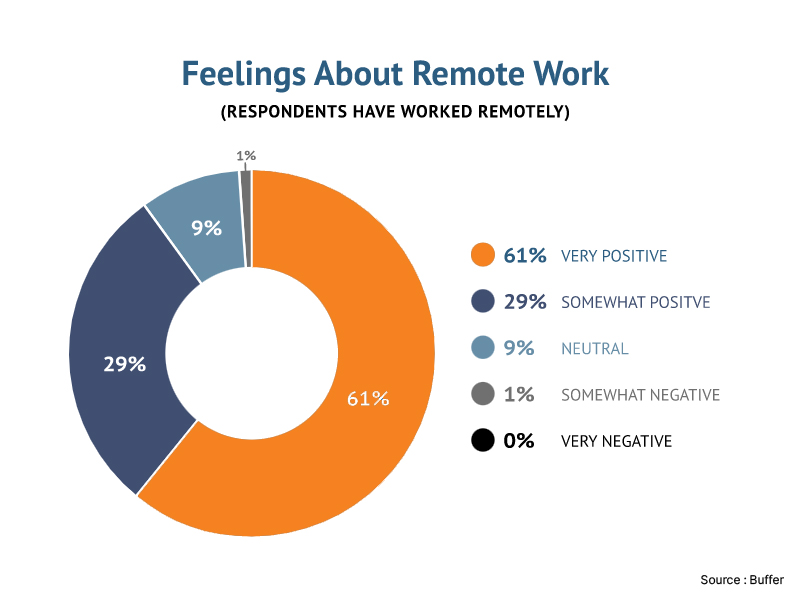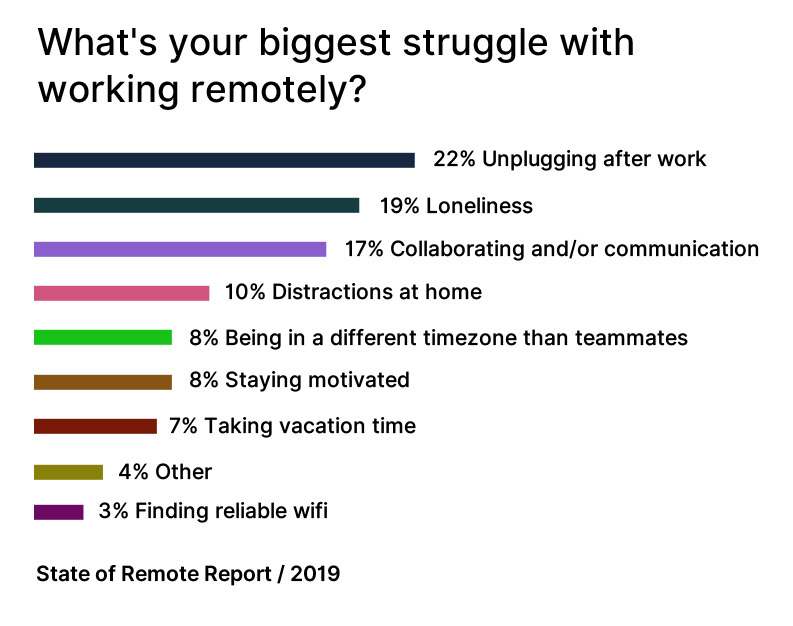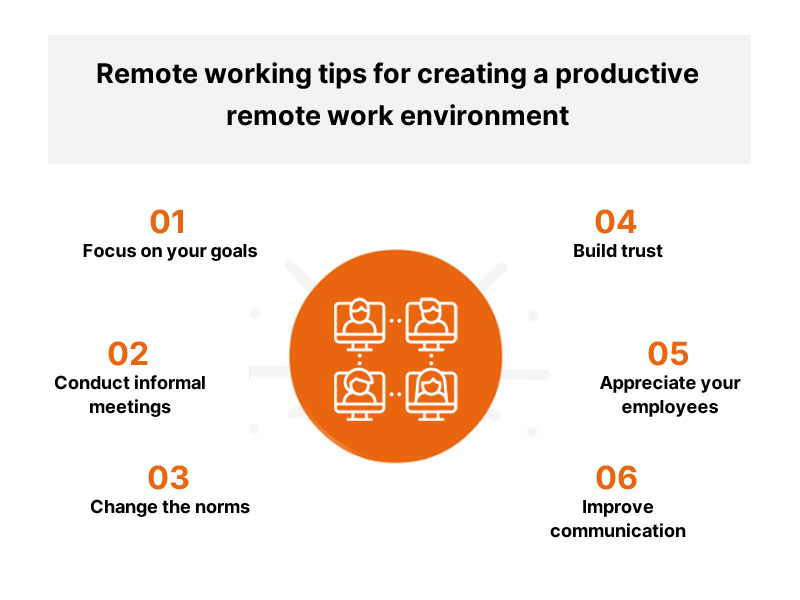In the last two years, the pandemic has reshaped some basic premises around work, hiring, and functions that revolve around interaction and collaboration.
Most work is remote, and workers increasingly prefer a remote engagement – adopting a remote working culture.
Working from home and flexible scheduling has become customary in practically every organization worldwide.
According to one survey, 65 percent of people wish to work remotely full-time after the pandemic. Nearly three-quarters of companies expect at least a portion of their employees to be remote after the pandemic.
Many companies find that remote working is changing and redefining their daily operations – and they enjoy it. However, a few organizations continue to endure challenges.

We’ve tried to merge challenges and bring solutions to concerns that businesses experience when implementing remote working.
Consider this a quick cheat sheet to build a healthy remote working culture.
Also read, Reasons Why Remote Teams is the go-to choice for Bootstrapped Startups

Source: Buffer
Remote Work Challenges Businesses Face
Problems with remote working occurs when best practices & fundamental notions of how remote teams work are not included. Here are the common challenges businesses face;
Trouble Managing Time
Working from home means a lot of hustle. And it’s all too easy to get sidetracked. When working from home, there are a few must-have distractions that you can’t avoid, like pets, household chores, or any family matter. You might end up with self-created distractions such as the web, social media, gaming, or more due to a lack of supervision, which is some of the most significant productivity hindrances.
You Might Overdo
Keeping your professional, and personal lives different is challenging when you need a commute or a method to get out of the workplace. When you’re on Wi-Fi, you can check work emails, talk with coworkers on Slack, or start working based on priority.
Furthermore, you may be concerned that your supervisor might think you are not working because you are off-site, so you overcompensate to appear productive.
Untrustworthy Technology
Inadequate tools and technologies can stifle productivity and morale in virtual teams. Poor broadband connections, unstable applications, and outdated equipment create frustration and severely reduce results.
Drains on Productivity
One of the reasons many managers oppose remote work is that they believe employees would slack off without actual or in-person supervision. It’s more challenging to switch off when your personal and professional lives coexist more complicated.
Overwork is more frequent in remote workers. There is no set time for beginning and finishing the day. Several employees even admit to having trouble recalling to take breaks.
You’re Experiencing FOMO
Being in an office with your team or colleagues fosters a sense of community. There are inside jokes, after-work cocktails on the spur of the moment, and unexpected events. Working from home can make you feel like you’re outside looking in.
Lack of Collaboration & Communication
Global tech behemoths are pouring resources into developing technologies that bridge the gap between teams and clients. Working on a project or merely debating a document remotely, no matter how advanced the remote collaboration platforms are, poses some problems.
Quick plug: If you are considering Remote work, consider hiring a dedicated remote development team or a dedicated developer that operates better, collaborates better, and provides services at a better cost. Consider staff augmentation and development services by Netsmartz and boot your IT operations quickly.
How to Develop a Productive Remote Working Environment
It’s a significant adjustment to work remotely for the first time. Experienced remote workers understand the importance of having the correct workspace and mindset.
Here are a few remote working tips for creating a productive remote work environment.

Concentrate on the Business Goals of Your Cultural Initiatives
Leaders cannot just virtualize components of their company culture and expect all employees to like the experience. Avoid just copying and pasting in-person rituals into an online version. Instead, consider the purpose of your workplace culture efforts and brainstorm ways to achieve it remotely.
If one of your company’s cultural traditions is to have quarter-end lunch outings where employees may connect, a virtual lunch meeting will likely provide a different experience.
Instead, consider the initial meeting’s purpose. If your purpose was to bring employees together, think of unique ideas to offer a similar experience for hybrid and remote workers.
Make Time for Informal Gatherings
Make sure, as a leader or business owner, you take out some time to make simple calls or arrange informal discussions where you hold virtual activities that are mind-relaxing, revitalizing, and fun. Coworkers can improve their connectivity by using casual chats in meetings to discuss personal life events.
Consider availing of video technologies that enable employees to see one another on their computer screens. Finally, encourage people to talk about their concerns and connect. If an employee develops serious issues, assist them in seeking guidance or medical treatment. When team-building activities are done, employees feel cared for and more aligned with their organization.
Establish New Norms for Your Business or Team
Companies must adopt new policies as employees work in a hybrid or remote environment. Ensure that employees are aware of the new remote work regulations and can put them into effect.
By communicating frequently, you can keep expectations clear and consistent. This further demonstrates the behavior you want your staff to emulate. Consider using solutions that allow your employees to contact one another regularly via a consolidated platform. This keeps teammates on the same page and informed about new policies and practices.
Build a Sense of Trust
A healthy remote work company environment relies heavily on trust. Refrain from assuming that workers who work from home are less productive. Allow your staff to manage their workloads without being micromanaged.
To make your business successful, the thumb rule is to focus on your employees’ enhancement rather than the number of hours they spend online.
Employee Appreciation for Outstanding Performance
Ensures that your leaders recognize their staff for positive outcomes and growth to make them feel appreciated, empowered, and heard. When recognized, employees are more aware of their happiness with their work.
Continue to acknowledge and praise hard work and appropriate behavior. This helps in the improvement of your employees’ performance.
Seamless Communication
Some teams use a messaging network like Slack and Zoom to bridge communication gaps, allowing everyone — remote and in-office — to communicate in real time about issues as they arise. They can also use cloud platforms for papers so everyone can work together.
Stay in touch with colleagues and projects via instant messaging and group chat, video call for meetings, and, most importantly, check in with colleagues and management. Make sure your camera is on during video calls so managers can see your body language and facial expressions.
Hire Remote Development Team: Remote Work is The New Normal
The premise is shifting how software companies work.
That is: With more leeway to explore while not being tethered to fixed hires.
Hiring remote development teams is way more fluid and on-point for new startups and enterprises looking to scale and grow without additional overheads.
Now, the older paradigms are being chucked out the window. With the pandemic, we’ve seen the breakdown of some of work culture’s oldest customs, like in-office collaboration and in-house teams.
With that in mind, CXOs and Founders should consider it essential to map productivity and foster a robust, conducive remote working environment.
They should further consider how to hire a remote development team or build a remote one in the first place.
Patience, adaptability, and a healthy dose of optimism are the most vital qualities for managing a remote work environment.
Focus on the long-term remote working benefits rather than what you’ll miss out on by leaving the workplace. Reduced commutes and more time with family; fewer distractions leading to increased attention and higher quality work; more time to exercise and leading healthier lifestyles are just a few of the remote workforce advantages.
To Wrap Up
In this blog, we’ve talked about remote work challenges and how to overcome them to keep a healthy remote working environment.
With the widespread use of required remote working, several strategies are being encouraged to overcome problems and retain team flexibility & balance to achieve effective results.
Build a highly skilled remote team for your Startup.
Request Free Consultation
Summary
Kickstart Your Project With Us!
Blog
Popular Posts
CONTACT US
Let's Build Your Agile Team.
Experience Netsmartz for 40 hours - No Cost, No Obligation.
Connect With Us Today!
Please fill out the form or send us an email to
 Don't Miss Out:
Don't Miss Out: 







